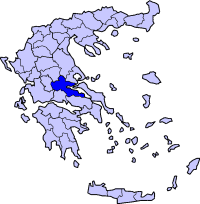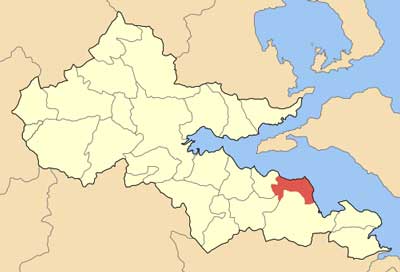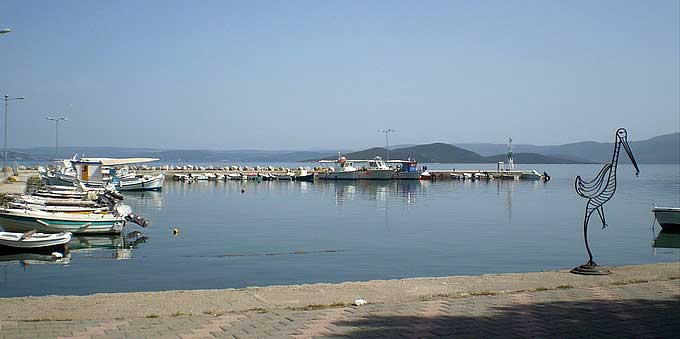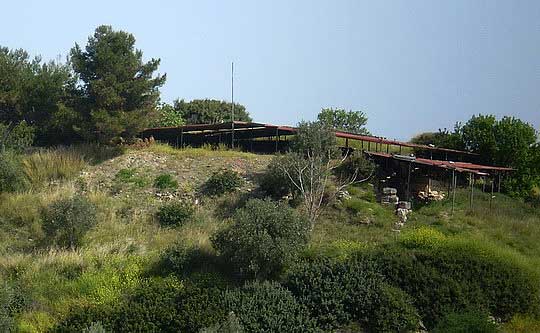.


Livanates (Greek: Λιβανάτες) is a seaside town (population in 2001: 3,023) in Phthiotis, central Greece. It is located 68 km southeast of Lamia and it was the seat of the municipality of Dafnousia from the mid 19th century until 2011.
History
Kynos, an ancient settlement site, can be found at the edge of the town. The medieval settlement was established by Arvanites. Livanates has been attested since 1540 as an Albanian settlement.[1] The Arvanitic dialect spoken in Livanates has some unique features that differentiate it from the other Arvanitic dialects.[2][3]

Livanates (Information about this image)
Livanates was famous for the Greek Revolutionary leader Odysseas Androutsos, his father Andreas Veroussis (known as Andritsos) was born in 1740. His monument is founded in the main square. He was chief of the Greeks and allied with Lambros Katsonis. Katsonis along with his tiny navy and Andritsos with 500 citizens and brought large disorder to the Turks and crushed their rebellion in the late 18th century. Andritsos was an excellent armatolos. In 1793, Katsonis were taken to Constantinople and were tortured to death.

Archeological find from the ancient Greek city "Kynos" (modern Livanates), which depicts for first time ever a naval battle. Can be seen in Archeological Museum of Atalanti. (Information about this image)
Livanates had 18 revolutionary leaders of Greek Revolution of 1821: Dimitriso Angelis, Anestis Georgiou, Antonios Ioannou, Ioannis Karalimba, Kyriakos Katsaros, Loukas Konsta and Pseftoura, Michalis and Angelis Michalopoulos, Panagiotis Mitzios and Tsiotis, Georgios Mougkos, Veroussis Nikolaou (first cousion of Odysseas Androutsos), Dimitrios Polyberopoulos, Giannakis Papatheodosiou, Nikos Staboulota, Dimos Stergiou, Makris Stergiou and Steriano, Ioannis Tselikas and Georgios Vergos.
In 1825, Odysseas Androutsos, hero of Battle of Gravia, with 600 Albanians marched to Livanadis where from March 31 to the following day, brought arms against Gkoura and Roukis. Later, it mentioned that the capture of Androutsos was done in Livanates. The officer of the government along with their leader Gkouras, changed lieutennants for Androutsos. When Androutsos disagreed with the government, he brought their men into the town. He was taken to the Acropolis in Athens where he was assassinated and hanged.

Livanates harbour (Information about this image)
Livanates was 1,021 people in the 1890s. On April 1894, a strong earthquake ravaged the town and killed 5 residents and injured 20 others.
During the occupation in World War II, an area known as "Kanada" (Canada) known its rich produce, due to its fertile ground feed many Athenians from hunger during World War II including wheat, potatoes, chick peas and cottons, as well as vegetables abundantly produced. Also Kynos hill was used for its military base as a camp and a prison during World War II.
Economy
The region produces meat, fish, potatoes, tomatoes, olives and olive oil, tobacco and cotton.
Landmarks
Notable sites are the Church of Agioi Theodoroi, a small Byzantine church which is an alleged site of krifo scholio, and the Monastery of the Transfiguration.
Livanates even has three beaches, Kyani Akti (Blue Coast) where its main beach located 1-1.5 km from the main square and Skinia and Ai-Giannis beaches.
Other
The Livanates Odysseas Androutsos Cultural Council' was formed in 1979, it is named after the famous hero of the Greek Revolution of 1821, it also has a women's council known as I Pyrrha and a football (soccer) club known as Dafni (prefectural (subregional) winner in 2002 and 2005 and cup winner in 2004).
Livanates, view of the coast overlooking Euboea
Livanates, view by the Ai Giannis church, near Kynos.

Archaeological Site Kynos (Information about this image)
Sources
^ Çiçek, Kemal; Göyünç, Nejat (2001). Pax Ottomana: studies in memoriam Prof. Dr. Nejat Göyünç. Yeni Türkiye. p. 173. ISBN 90-804409-6-5.
^ Anthropological linguistics. 25. Anthropology Department, Indiana University. 1983. p. 301.
^ Beeler, Madison (1980). American Indian and Indoeuropean studies: papers in honor of Madison S. Beeler. Mouton. p. 340. ISBN 90-279-7876-X.
Further reading
Dimitrios P. Avraam Lokrika, Lamia, 2001
Balta, Evangelia The Region of Atalanti and Moudounitza in the Ottoman Period (15th-16th Century), from ax Ottomana. Studies in Memoriam Prof. Dr. Nejat Göyünç, (ed.) Kemal Cicewk, Haarlem-Ankara 2001, Sota-Yeni Türkiye, 151-182
Biris, Kostas I. Arvanites - The gift of Modern Greek: History of Greek Arvanites (Αρβανίτες - Οι δωριείς του νεώτερου ελληνισμού: Ιστορία των Ελλήνων Αρβανιτών) Melissa 1998
Christoforou, Manthos L. I Opoundia Lokrida kai i Atalanti - Mnimes kai martyries (Opuntian Locris and Atalanta/Atalanti, Monuments and Memorials, Parts 1 (1991) and 2 (1993), Athens, Atalanti Historic and Folkloric Information Company (EILEA).
Christoforou, Manthos L. Opoudos (Opus) and Atalandi (Atalanta), Timeline of 4000 Years (Χρονολόγιο Οπούντος και Αταλάντης 4000 χρόνια – εν τάχει) - Municipality of Atalanti Publishers
Karastathis, Konstantinos Malesina, History, Memorials and Ancient Villages (Μαλεσίνα: Ιστορία, Μνημεία, Αρχαιολογικοί χώροι) 1999
Locrian Chronicles (Λοκρικά Χρονικά) Athens 1997, Atalanti Historic and Folkloric Information Company (EILEA), 3rd Edition
Mitsopoulos, K. 1895 The Great Locrian Earthquake in April 1894 (Ο μέγας της Λοκρίδος σεισμός – κατά τον Απρίλιο του 1894) Nattional Press, Athens 1895
Protopappas, Zisis (1952) Lokrida (Λοκρίδα), Athens
External links
Website with information about Livanates (Greek)
Municipal unit of Dafnoussia (Greek)
Municipal unit of Dafnoussia (Greek)
| Ancient Greece
Science, Technology , Medicine , Warfare, , Biographies , Life , Cities/Places/Maps , Arts , Literature , Philosophy ,Olympics, Mythology , History , Images Medieval Greece / Byzantine Empire Science, Technology, Arts, , Warfare , Literature, Biographies, Icons, History Modern Greece Cities, Islands, Regions, Fauna/Flora ,Biographies , History , Warfare, Science/Technology, Literature, Music , Arts , Film/Actors , Sport , Fashion --- |
Retrieved from "http://en.wikipedia.org/"
All text is available under the terms of the GNU Free Documentation License


